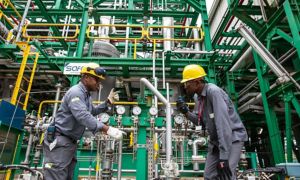Type of activity
Oil & Gas
Access to energy
Community health

Or , our new artificial intelligence tool.

In Libya, we are present in the exploration, development and production of hydrocarbons and are the leading international gas producer. In this way we help guarantee safe energy supplies to Europe while strengthening our ties with this increasingly strategic country. In line with our integrated approach, we promote initiatives in the country to guarantee access to energy and improve the quality of the health sector.
As well as promoting natural gas, in North Africa we champion projects based on the circular economy model, geared to the development of renewable energies and hydrogen, and focused on the capture, use and storage of CO2.
Activity start date: 1959 – present
Our natural gas exploration and production activities take place both onshore and off the coast of the country. It is the Green Stream gas pipeline that transports the gas produced at the Wafa and Bahr Essalam fields to Italy. Through the strategic Structures A&E project, scheduled for launch in 2026, we plan to increase our supplies to the domestic market and guarantee the continuity of gas exports. In line with our decarbonisation strategy, the project also involves the construction of a CO2 capture and storage plant (CCS) in Mellitah to reduce our overall carbon footprint. Negotiations for the launch of renewable energy development initiatives are currently ongoing.
Numerous projects have been launched across the country to improve access to energy and healthcare in communities. Is ongoing a professional training project in partnership with the International Organization for Migration targeting to increase youth employment in the south of country. We jointly manage various power plants, also supplying spare parts, and we train staff on safety issues. In the medical sphere, we launch initiatives to provide staff with professional updating and facilities with direct support. With the launch of the project to treat wastewater at Murzuq hospital, we are helping to safeguard the region.
annual gas production (billion cubic feet)
annual hydrocarbon production (millions of barrels of oil equivalent)
gas supplied (billion cubic meters)
Dahra Building
Tripoli
Dat El Imad Complex
P.O. Box 91651
Tripoli

If you want to change topic, clear the chat and make a new query to receive more relevant results.
This will delete the question history.
If you want to change topic, clear the chat and make a new query to receive more relevant results. This will delete the question history.
Here you can find the full list of your queries.
The answers are generated by artificial intelligence, therefore they may contain inaccuracies. Please read the terms and conditions of use.

EnergIA is an innovative tool based on artificial intelligence capabilities, which can help you navigate the contents of eni.com, quickly finding answers to your questions. EnergIA can also perform a search on a specific topic, providing the most up-to-date data available, or it can invite you to delve deeper into a topic of your interest by suggesting links and specific readings. Start now!
EnergIA is an innovative tool based on artificial intelligence capabilities, which can help you navigate the contents of eni.com, quickly finding answers to your questions. Start now!
EnergIA (ener'dʒia) is a system based on Generative Artificial Intelligence.
Thanks to this technology, we can respond to your requests by querying the most relevant content and documents available on eni.com. (Note: financial documents from the last 12 months and press releases from the last 2 years are considered.)
Through EnergIA, you can delve into topics of interest and have a real-time window into the world of Eni.
If you wish to search for a specific document, press release or news, use the traditional search engine via the magnifying glass icon.
Like all systems that leverage Generative Artificial Intelligence, EnergIA may generate inaccurate or outdated responses. Always consult the sources that EnergIA proposes as the origin of the generated information.
If the system fails to find an exact match for the requested content, it still tends to provide a response.
If you find any inaccuracies in the provided response, please send us your feedback at the bottom of the page: it will be very helpful for us to improve.
Remember that the content generated by the system does not represent Eni’s official position. We therefore invite stakeholders to refer to their designated contacts for official statements: Press Office for journalists, Investor Relations for analysts and investors, Company Secretariat for shareholders etc..
EnergIA can understand questions posed in almost all languages, but we prefer to provide you with a response in English or Italian, the two languages available on eni.com. If you ask a question in Italian, the content on the site in Italian will be consulted. If you ask it in English or any other language, the content in English will be consulted. (Note: the language Eni uses for financial documents/content is predominantly English.)
If questions are formulated that violate the set security criteria, the system will not proceed with processing the response. Please remember not to send personal data.
By using this service, the users acknowledge that they have read and accepted the terms and conditions of use.
Search
EnergIA (ener'dʒia) is a system based on Generative Artificial Intelligence.
Thanks to this technology, we can respond to your requests by querying the most relevant content and documents available on eni.com. (Note: financial documents from the last 12 months and press releases from the last 2 years are considered.)
Through EnergIA, you can delve into topics of interest and have a real-time window into the world of Eni.
If you wish to search for a specific document, press release or news, use the traditional search engine via the magnifying glass icon.
Like all systems that leverage Generative Artificial Intelligence, EnergIA may generate inaccurate or outdated responses. Always consult the sources that EnergIA proposes as the origin of the generated information.
If the system fails to find an exact match for the requested content, it still tends to provide a response.
If you find any inaccuracies in the provided response, please send us your feedback at the bottom of the page: it will be very helpful for us to improve.
Remember that the content generated by the system does not represent Eni’s official position. We therefore invite stakeholders to refer to their designated contacts for official statements: Press Office for journalists, Investor Relations for analysts and investors, Company Secretariat for shareholders etc..
EnergIA can understand questions posed in almost all languages, but we prefer to provide you with a response in English or Italian, the two languages available on eni.com. If you ask a question in Italian, the content on the site in Italian will be consulted. If you ask it in English or any other language, the content in English will be consulted. (Note: the language Eni uses for financial documents/content is predominantly English.)
If questions are formulated that violate the set security criteria, the system will not proceed with processing the response. Please remember not to send personal data.
By using this service, the users acknowledge that they have read and accepted the terms and conditions of use.
A new window into Eni’s world, at your disposal. EnergIA is an innovative tool based on artificial intelligence capabilities, which can help you navigate the contents of eni.com, quickly finding answers to your questions.


